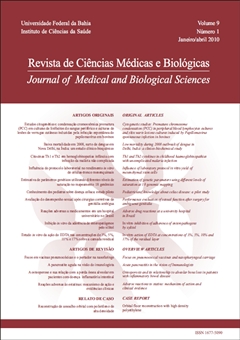Glicocorticoides e osteoporose – artigo de revisão
DOI:
https://doi.org/10.9771/cmbio.v9i1.4734Palabras clave:
Glicocorticoides e osteoporose – artigo de revisãoResumen
A osteoporose caracteriza-se como uma patologia de redução da densidade óssea mediada por maior atividade dos osteoclastos e diminuição ou alterações nas funções dos osteoblastos e osteócitos, comprometendo a homeostasia do tecido ósseo e favorecendo o risco de fraturas. Altas doses de glicocorticoides em conjunto ao seu uso prolongado no tratamento de diversas patologias, por sua ação antiinflamatória, induzirão a ocorrência da osteoporose secundária, ou osteoporose induzida por glicocorticoides. Métodos diagnósticos de imagem, a exemplo dos radiológicos, e métodos de diagnóstico laboratoriais, como os bioquímicos e hormonais, são ferramentas no acompanhamento e prevenção da terapêutica com glicocorticoides, visando atenuar os efeitos catabólicos desta patologia. A terapia com vitamina D associada ao cálcio tem apresentado bons resultados no tratamento da osteoporose induzida por glicocorticoides, por diminuir a reabsorção e aumentar a formação ósseas. Bifosfanatos tem apresentado maior efeito na inibição do processo de reabsorção óssea do que a vitamina D, porém, ambos devem ser ministrados juntamente com a suplementação de cálcio. Calcitonina, estrógenos e flúor são paliativos no tratamento.Descargas
Los datos de descargas todavía no están disponibles.
Descargas
Publicado
2010-11-18
Cómo citar
Souza, M. C. de, Assemany, F. S., Lima, A. T. C., & Souza, R. F. (2010). Glicocorticoides e osteoporose – artigo de revisão. Revista De Ciências Médicas E Biológicas, 9(1), 57–64. https://doi.org/10.9771/cmbio.v9i1.4734
Número
Sección
Artigos de revisão
Licencia
A Revista de Ciências Médicas e Biológicas reserva-se todos os direitos autorais dos trabalhos publicados, inclusive de tradução, permitindo, entretanto, a sua posterior reprodução como transcrição, com a devida citação de fonte. O periódico tem acesso livre e gratuito.






